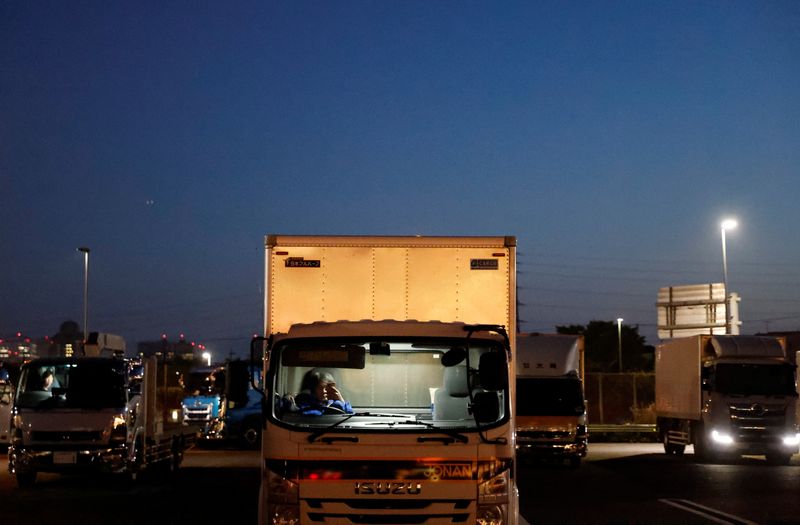
© Reuters. Delivery trucks are parked at a parking area along the highway in Chiba, east of Tokyo, Japan April 6, 2023. REUTERS/Issei Kato
2/5
By Mariko Katsumura and Satoshi Sugiyama
TOKYO (Reuters) – Truck driver Yuichi Tomita has been delivering packages all over Japan for two decades, often clocking 40 straight hours on the road. He says the work is tough but a source of pride, and one he’s never thought of quitting – until now.
On April 1, 2024, the government will limit truck drivers’ annual overtime to 960 hours, among other reforms officials say are meant to improve the job’s notoriously gruelling conditions and make it more attractive.
Drivers such as Tomita say the law will instead lead to an exodus from an occupation where most need those extra hours to pay the bills.
That has sparked fears of what those in retail and logistics call the “2024 crisis”: a critical shortage of truck drivers that, if unaddressed, could leave a third of all cargo undelivered and result in a potential 10 trillion yen ($76 billion) hit to the world’s third-largest economy by 2030, by government estimates.
“I’ve been doing this job for 20 years and you just can’t make ends meet on base pay alone,” said Tomita, a second-generation trucker and father of a 3-year-old. “I really think this crisis is going to threaten Japan’s economy and families like ours.”
Drivers make 4.46 million yen ($34,000) a year on average. That is about 10% below the average for all industries despite working 20% longer hours.
An expected drop-off in the number of truck drivers would set off a domino effect for farmers, shops and diners accustomed to next-day delivery of fresh fish and crisp produce.
The global consultancy Roland Berger expects a 20% decline in the number of Japanese truck drivers in the decade to 2030.
“Simply put, people in Tokyo will have no means to get fresh vegetables or fish from Kyushu (in southern Japan) and other far-off regions,” said Masashi Onozuka, a partner at consultancy
Roland Berger who serves on the government’s study group for
sustainable logistics systems. “That could affect consumer spending and other areas too.”
SQUEEZED
About 98% of Japan’s 62,000 trucking companies – responsible for delivering almost all of the country’s cargo – are small operations. Fierce competition and high fuel prices mean truck drivers are squeezed too despite an acute labour shortage.
A recent government survey showed trucking companies were able to pass on only 19% of their cost increases, compared with 47% for small- and medium-sized firms. That would make it difficult for small companies to hire to make up for the lower number of legal working hours per driver.
Underscoring the difficulties smaller players face, the Fair Trade Commission in December named and shamed 13 firms that it said abused their superior bargaining power to refuse price increase requests from smaller contractors and suppliers. Six were logistics and delivery majors, including Trancom and Sagawa Express. Both companies promised to make improvements.
Prime Minister Fumio Kishida last month instructed his cabinet to come up with “drastic” measures by June to address the crisis. A dedicated lane over a 100km (62-mile) stretch of highway connecting Tokyo and Nagoya for self-driving trucks and a flight route for delivery drones are planned from next fiscal year.
Some retailers have devised ways to soften the impact.
Convenience store operator Lawson will reduce deliveries of lunch boxes to twice a day from three times for all outlets by April 2024. Supermarket chain operators Summit, Maruetsu, Yaoko and Life Corp agreed to allow an extra day for delivery and reduce overnight shipping.
Many far-flung producers, though, have no plan.
Farmers and fish wholesalers from Kyushu to the northernmost island of Hokkaido fear for their livelihood and local economies if there aren’t enough drivers.
Masaaki Iwamori, an official at the Ehime Fishers Cooperative on the western island of Shikoku, said the town of Uwajima could wither without trucks to deliver its famed amberjack by 2 a.m. to Tokyo’s main fish market, a 12-hour drive away.
“If the fish aren’t ready in time, they lose their freshness when they’re auctioned the next day” at a significant discount, he said. “Maybe once consumers start noticing the drop in quality, they’ll share the sense of crisis.”
($1 = 131.3800 yen)





